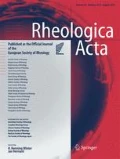Résumé
Une méthode très sensible d'étude in vitro des propriétés rhéologiques du sang en régime d'écoulement transitoire à faible vitesse de cisaillement développée récemment permet de mettre en évidence avec précision la viscoélasticité et la thixotropie du sang à partir de l'enregistrement de quatre rhéogrammes obtenus en quelques minutes, dans des conditions mécaniques différentes et selon un protocole expérimental standard bien défini, sur un même échantillon de sang de quelques cm3. On peut ainsi caractériser un sang donné au moyen d'un petit nombre de paramètres mécaniques.
Cette technique a été utilisée pour montrer que des sangs humains considérés comme normaux du point de vue hématologique peuvent présenter des différences notables de comportement rhéologique, ce qui a des conséquences au niveau de l'hémodynamique. D'autre part il est prouvé sur plusieurs exemples que la viscosité, la viscoélasticité et la thixotropie du sang présentent souvent des variations considérables dans le cas de sangs artificiellement modifiés. Ceci montre l'importance du rôle que pourrait jouer l'utilisation de la technique proposée dans le domaine de l'hématologie normale et pathologique.
Summary
A very sensitive method has recently been developed for the study in vitro of the rheological properties of blood in transient flow at low shear rate. By this method the blood viscoelasticity and thixotropy can be evidenced accurately from the recording of four rheograms corresponding to four different flow conditions, and obtained in well defined and invariable experimental process with the same small blood sample. Thus a given blood can be characterized by means of a small number of mechanical parameters.
This method has been used to show that human blood samples, considered as normal from hematological point of view, may exhibit large and reproducible differences of rheological behaviour, which is important for the hemodynamical consequences. On the other hand, it has been demonstrated, on several examples, that viscosity, viscoelasticity and thixotropy of blood frequently show considerable variations when the blood samples are artificially modified. This emphasizes the major role the use of the proposed method may play in the domain of normal and pathological hematology.
Zusammenfassung
Vor kurzem wurde eine sehr empfindliche Methode entwickelt, um die rheologischen Eigenschaften von Blut unter nicht-stationären Bedingungen bei niedrigen Schergeschwindigkeiten in vitro zu untersuchen. Hiermit lassen sich die Viskoelastizität und die Thixotropie des Blutes anhand von vier Rheogrammen genau bestimmen, wobei vier verschiedene Fließvorgänge gemäß einem exakt reproduzierbaren Versuchsprogramm an ein und derselben kleinen Blutprobe realisiert werden. Auf diese Weise ist das vorgegebene Blut mittels einer kleinen Anzahl mechanischer Parameter charakterisierbar.
Diese Methode wurde angewandt, um zu zeigen, daß vom hämatologischen Standpunkt normales Humanblut bezüglich seines rheologischen Verhaltens erhebliche und reproduzierbare Unterschiede aufweisen kann, die wichtige hämodynamische Folgen haben. Weiterhin wurde an verschiedenen Beispielen nachgewiesen, daß die Viskosität, Elastizität und Thixotropie von Blut durch künstlich vorgenommene Modifikationen wesentlich verändert werden kann. Dies macht die wichtige Rolle deutlich, die derartige vorgeschlagene Methoden für die normale und pathologische Hämatologie zu spielen imstande sein dürften.
Bibliographie
Bureau, M., J. C. Healy, D. Bourgoin, M. Joly, Rheol. Acta17, 612–625 (1978).
Healy, J. C., M. Joly, Biorheology12, 335–340 (1975).
Apelblat, A., D. Bourgoin, J. C. Healy, M. Joly, Proc. 7th Int. Congr. Rheology, pp. 570–571 (Göteborg 1976).
Bureau, M., Thèse 3ème cycle (Paris 1977).
Healy, J. C., Thèse Doct. Etat (Paris 1973).
Mason-Guest, M., T. P. Bond, 1st World Cong. Microcirculation, Communication n° 173 (Toronto 1975).
Rakow, A. L., R. M. Hochmuth, Biorheology12, 1–3 (1975).
Tenforde, T., Adv. in Biol. Med. Physics13, 43–105 (1970).
Hint, H., in:J. R. Derrick, M. Mason Guest (eds.), Dextrans, Current Concepts of Basic Action and Clinical Applications, pp. 3–26, Thomas Publ. (1971).
Gregerson, M. I., in:J. R. Derrick, M. Mason-Guest (eds.), Dextrans, Current Concepts of Basic Action and Clinical Applications, pp. 27–38, Thomas Publ. (1971).
Obrecht, B., P. Rusch, J. C. Healy, Biorheology (à paraître).
Author information
Authors and Affiliations
Additional information
Avec 8 figures et 5 tableaux
Rights and permissions
About this article
Cite this article
Bureau, M., Healy, J.C., Bourgoin, D. et al. Etude rhéologique en régime transitoire de quelques échantillons de sangs humains artificiellement modifiés. Rheol Acta 18, 756–768 (1979). https://doi.org/10.1007/BF01533351
Received:
Issue Date:
DOI: https://doi.org/10.1007/BF01533351

